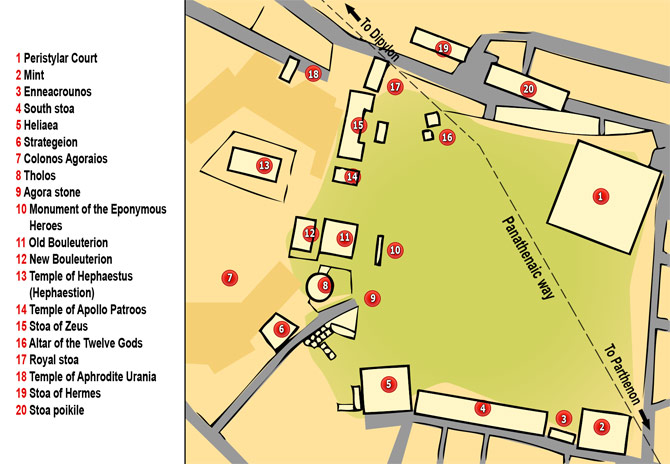The Ancient Agora of Athens
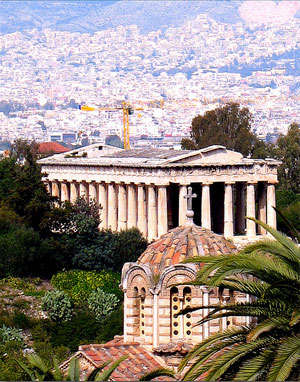
The location of the Ancient Agora (Archaia Agora) of Athens, that is the political and cultural center of the early Athenian city state (polis), is the subject of a long standing and vigorous debate. Until the discovery in 1980 of a Hellenistic inscription which identified securely the location of the Cave of Aglavros at the eastern end of the Acropolis, the Ancient Agora was thought by many to lie either in the level area between the Areios Pagos hill and the west entrance to the Acropolis or where the Classical and later Agora was located. After the reforms of Kleisthenes in 508/7 BC, which established the nascent demokratia (sovereign rule of the citizens) as the form of government in Athens, the administrative center of the city was moved to the location now known as the Agora of Athens or the Agora of Kerameikos, to the northwest of the Acropolis and to the north of the Areios Pagos hill. This transfer would have been necessary to accommodate the larger space required for the buildings associated with the new political institutions and civic cults. Up to this time, according to John Papadopoulos (University of California-Los Angeles), the area of the new Agora was an area devoted to industrial activities and cemeteries.
The consensus now is that the Ancient Agora must have been somewhere below the northeastern or eastern slopes of the Acropolis. In as much as no systematic or extensive excavations have been made in this area, nor are none likely in the foreseeable future one can only speculate on this crucial topic of Athenian topography. Recently, three scholars have put forth somewhat similar but still different views on this Agora's location. As you walk through Plaka and Anafiotika, where each scholar thinks this Agora was situated, more information will be provided. The major political, religious and cultural buildings as well as related civic monuments associated with the Agora will be surveyed first. In addition to these buildings (below), there was the Epilykeion (where the Polemarch the chief military officer, held office), the Thesmotheteion (where from Solon's time onward the six junior annual magistrates, the Thesmothetai, met with the three senior ones) and the Basileion (where the old Phylobasileis, tribal kings, of the four Ionic tribes met). In the Ancient Agora there was the Altar of Pity where suppliants to Zeus sought refuge. The space was large enough for the Athenian hoplite corp to muster here.
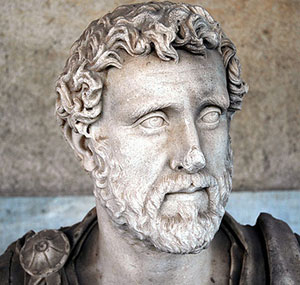
A. Prytaneion. This building, the original city hall and at one time meeting place of the Council (boule) of the Areios Pagos and later Solon's Council (boule) of the 400, housed the sacred hearth of the goddess Hestia. This was the symbolic civic hearth of the polis. The Prytaneion was the architectural symbol of the ancient coming together or unification (synoikismos) of the small communities of Attica mythically fostered by Theseus. He was credited with forming the Athenian city-state (polis), its communal festival, the Panathenaia, as well as founding this building. It not only served as the office of the Eponymos Archon (the annually elected magistrate whose name was given to designate the year in which he served) and a court for certain types of lawsuits, but was used also as a communal dining hall for major civic officials and official guests of the city. Select prominent citizens and their descendants could dine here for life. Foreign ambassadors and the proxeni (official representatives) of other city-states were entertained here as well. Each youth (ephebos) doing his military service, when registered as a citizen of the polls at the age of 18, made a sacrifice at this hearth. The wooden tablets (axones) on which the laws of Solon (early 6th century lawgiver and lyric poet) were painted, were kept here until the beginning of the 5th century BC. The statues of the Tyrannicides, Aristogeiton and Harmodios, who assassinated Hipparchos, the brother of the tyrant Hippias in 514 BC, and the patriots Miltiades (who masterminded the Athenian victory over the Persians at the battle of Marathon in 490 BC), Themistokles (who masterminded the creation of the Athenian navy and the resistance to the second Persian invasion in 480/79 BC) and Demosthenes (the man who convinced finally the Athenians to attempt to resist the advance of Philip II of Macedon, in the 340s/330s BC) were located here as well.
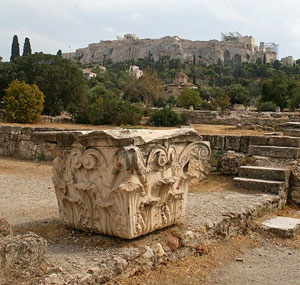
B. Shrine of Theseus / Theseion. This hero's shrine was founded or enlarged by the general and political leader Kimon in 476/5 BC to house the bones of the national hero Theseus, which he claimed to have discovered on the island of Skyros in the southern Sporades. As far as one can determine, there was a naiskos-like building which housed the bones as well as a temple set within an enclosed temenos where a series of altars stood. The area was large enough for Athenian citizens to muster here for voting, military assembly and other matters such as the annual allotments of public offices by the Thesmothetai. In the naiskos there were large-scale paintings dating from 475/470 BC on each of the four walls, depicting: Theseus' visit to Poseidon; Theseus participation in the Amazonomachia (the battle of Greeks versus Amazons; Theseus' involvement in the Thessalian Centauromachia (the battle of Greeks versus Centaurs); the return of Theseus. The painter Mikon may have painted one or all of these and it is also possible that the painter Polygnotos early in his career executed the Centauromachia. There was also a statue group of Theseus and the Minotaur. The festival in honor of Theseus, the Theseia, was held here too. The Theseion, in general, and its naiskos, in particular, were places of asylum for slaves. Some lawsuits were pleaded here too.
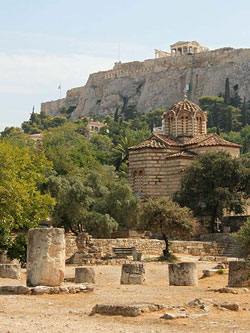
Diane Harris-Cline (Georgetown University) believes that Kimon was able to build such a shrine in this place because there was here an earlier, but no longer functioning, sacred area. She believes that the ancient Altars of the Dread Goddesses were located here previously. They served traditionally as a place of asylum for suppliants. This function was inherited by the later Theseion. The altars were transferred to the Areios Pagos probably after the reforms of Solon in 594 BC. In 632 BC they had been polluted by the murder of the followers of Kylon who were attempting to seek refuge there. This occurred after Kylon (an aristocrat, Olympic victor and son-in-law of Theagenes, the tyrant of Megara) attempted to make himself tyrant of the city by occupying the Acropolis with his followers. The annual magistrates resisted and blockaded them in the citadel. Deprived of food or water, they were forced to give up finally. While Kylon and a few others escaped, the majority were trapped. They attempted to seek refuge by clinging to the cult statue of Athena Polias or by sitting on the altar in front of her temple clutching a string attached to this statue. Then they were convinced that they would be tried for their crime by the Council in the Prytaneion in the Ancient Agora. After descending by the northeastern (or Mycenaean) gate near the Erechtheion they were attacked and killed before they could reach the Prytaneion.
Beside the Theseion was Horkomosion (The oath-taking place), where the annual magistrates took their oath of office and the heralds proclaimed their messages. They did this by standing on the herald's stone. T.L. Shear, Jr. (Princeton University) believes that this stone was moved from this place and put against the stylobate of the Basileios Stoa in Agora. This large, roughly-worked slab of poros limestone with a very worn upper surface, continued to serve probably in its new position as focal point of such ancient rituals in Athenian public life.
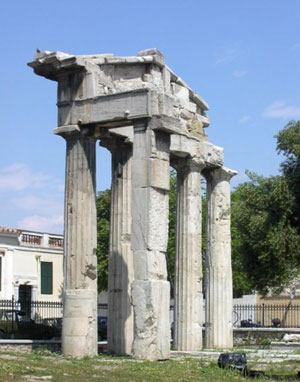
C. Anakeion / Dioskoureion. At the base of the Acropolis' steeper slopes and closely connected with the Thision and the Aglavreion (which was immediately above it) was another important sanctuary, the Anakeion or Dioskoureion (dedicated to the Anakes or to the Dioskouroi, Kastor and Polydeukes). From various references we have, it must have consisted of a large, open area suitable for the mustering and overnight stay of the Athenian cavalry in 415 BC, prior to its departure on the ill-fated Sicilian Expedition during the second phase of the Peloponnesian War. As Pausanias mentions a painting here, there would have been some building as well.
D. Boukoleion. Near the Prytaneion was the Boukoleion which served as the office of the Archon Basileus (King), until the early 5th century BC, when it was moved to the Basileios Stoa in the Agora. The primary responsibilities of this annual magistrate were justice and religious matters. Each year his wife was symbolically married to the god Dionysos in this building, which was also used for his cult.
E. Gymnasion of Diogenes Euergetes / Diogeneion. This gymnasion (or more likely a palaistra - the enclosed wrestling/training ground normally associated with a gymnasion) of unknown plan honored Diogenes Euergetes (the benefactor), the Macedonian general in Attica who liberated Athens, Piraeus, Salamis and Attica from Macedonian control in 229 BC. This military and political domination by Macedon began after Athens took the wrong side in the Chremonidian War which ended in 261 BC. Diogenes did this after the death of the Macedonian King Demetrios II, son of Antigonos Gonatas. He probably was persuaded to disband his troops with the financial encouragement mostly from the Athenians and partially from Aratos of Sicyon, the leader of the Achaean League. Within its boundaries there was his hero shrine. A festival with games were held here in his honor. He received a special seat of honor (proedria) in the front row of the Theater of Dionysos.
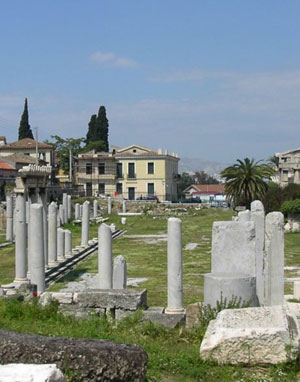
The great importance of this complex for the Athenian polis in the Hellenistic period revolves around the Ephebeia (the corps of epheboi, 18- and 19-year old young male citizens doing their military service), which trained here. Christian Habicht (University of California-Berkeley) believes that the Theseion commemorates the person who first brought the polls of Athens to life; the Diogeneion honors the person who gave new life to the city; and the Ptolemaion praises the person who ensured the continuation of that new life. To understand this proposal one requires some basic background information.
Shortly after Athens' disastrous defeat by Philip II of Macedon in the battle of Chaironeia (in Boeotia, Central Greece) in 338 BC, the city experienced a revival of national spirit and readiness under the leadership of the statesman and financier Lykourgos. The Ephebeia were reorganized in 336 BC and made a compulsory two-year service for military training as well as indoctrination in patriotism and piety. The cost of this and their weapons were paid for by the polis. While most of their time was spent either in the Piraeus (first year) or on the frontiers of Attica (second year) as scouts/rangers, apparently they used the refurbished Theseion as their administrative center and trained in the newly expanded gymnasion in the Lykeion outside the city walls, where Aristotle established his famous Peripatetic School in 335 BC. The declining fortunes of Athens after 322 BC, with almost constant resident Macedonian military garrisons at various locations in Attica resulted in the collapse of the Ephebeia. Diogenes' freeing of Athens from Macedonian domination in 229 BC prompted another reorganization of the Ephebeia. The service was made optional and for only one year. As the epheboi had to provide their own weapons and equipment, this meant that only the sons of the wealthy who wished to pursue a public career participated. It was, in effect, for the next 135 years an elite school centered on the Diogeneion for future leaders of the polls and not an effective military force. The hero cult of Diogenes and his annual festival were associated almost exclusively with the Ephebeia. The nearby Ptolemaion was also used for the training and the continuing formal education of the epheboi, through the attendance of the lectures at one of the various philosophical schools located in these complexes.
The finds of numerous inscriptions mentioning the Diogeneion in and around the now demolished Byzantine church of Aghios Demetrios Katiphoris has led many scholars to believe that its location was in the immediate vicinity. Professor Stephen G. Miller (University of California-Berkeley) believes it was situated more to the northeast of his Ptolemaion where architectural remains were discovered in the small plots formed by Adrianou str., Flessa str., Kyrristou str. and Erectheos str.
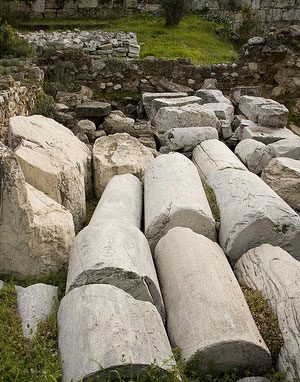
F. Gymnasion of Ptolemaios III Euergetes / Ptolemeion. The funds for the construction and upkeep of a modern-style gymnasion in the urban core of the city were donated in 224/3 BC by Ptolemaios III Euergetes (the benefactor, ruler of the Ptolemaic kingdom of Egypt: 246-221 BC) through his envoy to Athens, Thraseas. The purpose of this gift by the quasi-official protector of Athens' independence from the Macedonian King Antigonos Doson, and leading benefactor of the city, was to reinforce the existing ties between his kingdom and the polls. In return for this largesse Athens established a priesthood and a festival in his honor, the Ptolemaia, as well as creating a new, 13th tribe (phyle), called Ptolemais. A new deme, Berenikidai, was created for this tribe, named after his wife, Queen Bereniki. A hero cult was created for them as well. This gymnasion was one of the principal training areas for the epheboi from this time until the Herulian sack of the city in AD 267. A student of the New Academy, the skeptic philosopher Karneades from Cyrene, (214-129 BC) set up a school here in the mid-2nd century BC. Besides a library and numerous honorific statues, a grove of trees may have been a feature of the gymnasion.
Professor Miller believes that this complex could only have been built in an open area which already existed and had sufficient flat space for the two requisite long practice tracks or stadia: the open paradromis and the covered xystos in a stoa-like building. A road led from the eastern portal of the Market of Caesar and Augustus past the Tower of the Winds to the east, roughly parallel to the slopes of the Acropolis (approximately along a line now under the buildings on the north side of Lysiou str.). This must have been an ancient one, which started at the southern end of the Stoa of Attalos on the east side of the Agora, with the later Roman Agora interrupting its path. Miller implies that this straight road where the gymnikoi agones (athletic competitions with nude participants) were held during the Panathenaic festival from c. 566 until c. 330 BC, when they were reorganized and transferred to the Lykourgos' new stadion outside of the city walls. The mousikoi agones (music competitions) were also held in this area until they were transferred to the Odeion of Perikles in the 440s BC. The celebration of these events here was appropriate as it was adjacent to the Theseion (the shrine of the mythical founder of the festival) which he places in the general area of church of Timia Zoni tis Theotokou kai Aghios Spyridon on Lysiou str. Thus, this existing straight road used in the past for athletic contests would have served as the practice track (paradromis) of the new gymnasion.
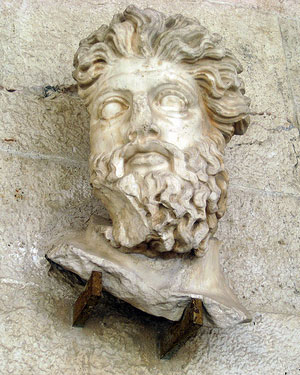
Immediately to the east of the Tower of the Winds, on the north side of the proposed ancient road, there are foundations visible (which continue under Markou Avriliou str.) that have been associated typically with the so-called Agoranomeion. Miller, on the other hand, argues that this was the western end of a long and broad stoa, built parallel to the existing road. The stoa, which he reconstructs as stretching to the east (in essence the southern side of modern Kyrrhistou str. runs along its longitudinal axis) served as the covered practice track of the gymnasion. The building probably was damaged or destroyed by Sulla's soldiers, who sacked Athens in March 86 BC, after a protracted siege. The Ptolemeion was rebuilt in the early imperial period, c. 30/20 BC, at the expense of Juba II. As his marriage to Cleopatra arranged probably by Octavia and Augustus who set him up in Mauritania c. 25 BC, Miller sees Juba II as one of the cultural agents of Augustus. Juba II was an individual of extensive learning who wrote many books, all now lost. This rebuilt complex influenced clearly the line and orientation of the eastern side of the Roman Agora and the Pantheon.
The Greek architect and architectural historian Manolis Korres (Greek Archaeological Service) believes that spolia from the stows colonnade was reused in the repair of the Parthenon's interior in the 4th century AD and of the Asklepieion on the southern side of the Acropolis. The substantial ruins of the structure's eastern end were incorporated apparently in the eastern line of the Late Roman Fortification wall. Miller believes that the arched marble lintel of the so-called Agoranomeion' s facade was originally a part of a building in the gymnasion complex, which subsequently was moved to its present location and inserted in an existing wall to serve as a monumental entrance way with a wide staircase and ramp on its west side. With the location of the gymnasion of Ptolemy fixed Prof. Miller, argues that it formed the northern side of the Ancient Agora which he locates as lying to the south, between Lysiou str. and Prytaniou str., below the northeast slopes of the Acropolis. Markou Avriliou str. on the west and the eastern line of the Late Roman Fortification wall would be its other approximate limits. He restores the Theseion on its western side, the Anakeion on its eastern side and, farther to the east, the Prytaneion, whereTripodon str. jogs to meet Flessa str. Thus, agreeing with the idea that the ancient street called Tripodes (under the modern Tripodon str.) ran in an arc around the eastern end of the Acropolis, from the Prytaneion to the Sanctuary of Dionysos. This is counter to loannis Travlos' reconstruction, that has this street run westward all the way to the City Eleusinion, where it bifurcates to reach finally the Panathenaic Way on either end of the sanctuary. With this background information in mind let's proceed.
